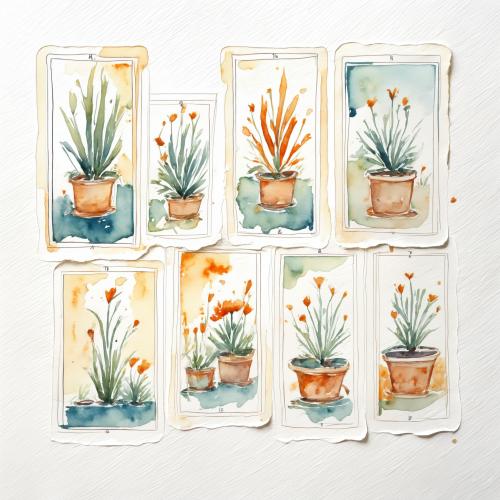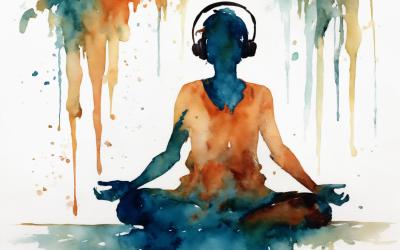Shame lurks in the shadows of our psyche, whispering that we're not just people who've made mistakes, but that we are mistakes. Unlike guilt, which says "I did something bad" shame insists "I am bad." Through tarot's symbolic language, we can bring this painful emotion into the light, examining it with compassion rather than judgment. This journey isn't about eliminating shame entirely, but transforming our relationship with it—moving from prisoners of our past to students of our own experience.
Understanding Shame Through Tarot's Lens
Shame is a peculiar emotion. It convinces us we're alone in our flaws while simultaneously being one of the most universal human experiences. It's rather like believing you're the only person who's ever tripped in public, while walking through a world of people who've all done the same but are too embarrassed to mention it.
The difference between healthy regret and toxic shame lies primarily in how we relate to our actions. Regret says, "That choice didn't align with my values, and I can learn from it." Shame says, "That choice proves I'm fundamentally flawed and unworthy of connection." One is a compass; the other is a prison.
Shame often manifests through predictable patterns:
- Perfectionism (If I'm perfect, no one will see my "real" self)
- Withdrawal (If I hide, my unworthiness won't be discovered)
- Aggression (I'll attack before others can reject me)
- People-pleasing (If I'm useful enough, perhaps I'll be acceptable)
- Self-sabotage (I'll ensure my failure before others can witness it)
These patterns aren't character flaws; they're protective strategies that once helped us survive. The problem isn't that they exist, but that they've outlived their usefulness while continuing to exact a heavy cost.
Cards That Illuminate the Shame Experience
Certain cards in the tarot deck seem to speak directly to the experience of shame, offering mirrors that reflect this difficult emotion with surprising accuracy.
The Devil
The Devil card presents a masterful portrayal of shame's peculiar power. Notice how the figures aren't actually imprisoned—they're adorned with chains loose enough to slip over their heads at any moment. Yet they stand in place, convinced of their captivity. This is shame's greatest illusion: the invisible prison whose doors are actually unlocked.
What makes shame so insidious isn't external constraint but internal conviction—the quiet, persistent belief that our flaws aren't merely aspects of being human but proof of our fundamental unworthiness. This card shows how we become collaborators in our own confinement, accepting limitations that exist primarily in our minds.
The Devil also reveals shame's tendency to isolate us. Each figure in the card stands separately chained, unable to see that the other experiences the same predicament. This mirrors how shame convinces us our flaws are uniquely terrible, preventing us from recognizing the universal nature of imperfection and vulnerability.
Eight of Swords
The Eight of Swords depicts a blindfolded figure surrounded by swords, apparently trapped but with space to move if only they could see it. This is shame's cognitive prison: the belief that we're irredeemably flawed creates a mental cage that feels inescapable, despite the existence of paths forward.
This card reminds us that shame distorts our vision, making us blind to possibilities for healing and connection that actually exist. The first step toward freedom often involves simply questioning whether the limitations we perceive are as fixed as they appear.
Five of Cups
The figure in the Five of Cups mourns three spilled cups while failing to notice two full ones standing behind them. This perfectly captures shame's selective attention—how it fixates on our perceived failures while rendering our strengths, successes, and connections invisible.
This card doesn't dismiss genuine loss or suggest "looking on the bright side." Instead, it asks whether our perspective has become so narrowed by shame that we're missing important parts of a more complex reality.
Ten of Wands
The Ten of Wands shows a figure struggling under a heavy bundle of sticks, bent forward, face hidden. This is the physical experience of carrying shame—the heaviness, the downward gaze, the way it obscures our view of the path ahead.
This card asks whether we need to continue bearing all this weight alone. What might happen if we set down some of these sticks, or allowed someone else to help carry them? What if this burden isn't actually ours to bear?
The Journey From Shame to Self-Acceptance
Healing shame isn't a linear process with a tidy endpoint. It's more like learning to dance with a difficult partner—gradually becoming more skilled at recognizing its moves and responding differently. The Major Arcana offers a framework for understanding this journey.
Phase 1: Recognition (Tower/Judgement)
The Tower represents moments when our defenses against shame suddenly crumble. Perhaps a crisis forces us to confront patterns we've long denied. Or maybe we simply reach a point where the cost of avoiding our shame exceeds the pain of facing it.
Judgement follows, calling us to honest self-evaluation. Not harsh judgment, but the clear-eyed recognition of how shame has shaped our lives. This card asks us to hear the call toward healing without minimizing the past or flogging ourselves for it.
Working with these cards:
- Notice when shame arises in your body. Where do you feel it? How does it move?
- Write down the specific messages your shame voice tells you
- Distinguish between behaviours (which can change) and perceived character flaws (which shame tells us are fixed)
Phase 2: Compassion (Star/Temperance)
The Star follows destruction with gentle hope. After facing our shame, this card offers healing waters and the guidance of light. It suggests that exposure of our shame to ourselves (and possibly trusted others) doesn't lead to the rejection we feared, but to the possibility of refreshment.
Temperance teaches the alchemy of integration—the patient blending of aspects we've tried to disown with those we've been willing to claim. It suggests that healing comes not from eliminating parts of ourselves, but from bringing them into balance.
Working with these cards:
- Speak to your shame with the gentleness you'd offer a frightened child
- Practice mindful awareness of shame without trying to change or flee it
- Notice the difference between behaviours you can modify and circumstances beyond your control
Phase 3: Integration (Strength/The Sun)
Strength depicts mastery not through domination but gentle power. This represents our growing ability to face shame without being overwhelmed by it. The woman isn't fighting the lion or running from it—she's in relationship with this powerful force, neither controlled by it nor attempting to control it.
The Sun brings illumination after the confusion of shame's shadows. It represents moments of genuine joy and self-acceptance that become increasingly possible as shame loosens its grip. These aren't permanent states, but they offer powerful evidence against shame's insistence that we're fundamentally flawed.
Working with these cards:
- Celebrate small moments of responding to shame differently
- Practice self-forgiveness as an ongoing process rather than a one-time event
- Allow yourself to experience joy without feeling you need to "earn" it
Phase 4: Wisdom (The World)
The World completes this journey, representing not the absence of shame but a new relationship with it. The dancing figure at the center has integrated the four elements surrounding them—suggesting that we can incorporate all aspects of our experience, including shame, into a more whole sense of self.
This isn't about reaching perfection, but about embracing our full humanity. The most shame-resilient people aren't those who never feel shame, but those who recognize it without being defined by it. They've learned to hold shame as one experience among many rather than the defining truth of their identity.
Working with these cards:
- Notice how your relationship with shame has evolved
- Practice telling your story with compassion rather than condemnation
- Use your experience to foster genuine connection rather than isolation
Practical Tarot Exercises for Working with Shame
The Shame Origins Spread
- The nature of my shame (what it feels like)
- The origin of this shame (where it came from)
- How this shame has protected me
- How this shame limits me now
- A gentle step toward healing
- What acceptance might look like
Use this spread when you're feeling triggered by shame, or when exploring a specific shame-inducing memory or pattern.
The Shadow Integration Spread
- An aspect of myself I've rejected
- Why I've found this difficult to accept
- The cost of this rejection
- The gift hidden within this aspect
- How I might begin to reclaim this part
- What integration would bring to my life
This spread works well for exploring qualities or impulses you've denied because they seem unacceptable or dangerous.
The Compassion Building Spread
- How I speak to myself when I fail
- A more compassionate perspective
- My fear about self-compassion
- The truth about self-compassion
- A small practice to build self-kindness
Use this spread when your inner critic is particularly loud or when shame has triggered harsh self-judgment.
Single Card Meditations
Sometimes simpler is better, especially when emotions run high. Try working with a single card as a focus for reflection:
- The Star: Hold this card during a meditation on self-compassion
- Temperance: Focus on this card while practicing balance between accountability and kindness
- The Hanged Man: Use this card to explore new perspectives on shameful experiences
- Eight of Cups: Reflect on what you might need to walk away from to heal
Moving Beyond Intellectual Understanding
While cognitive insights matter, shame lives in the body and often requires somatic approaches for true healing. Consider these embodied practices with tarot:
- Place The Star or Strength card on your heart while practicing deep breathing
- Physically act out breaking The Devil's chains
- Hold the Ten of Wands, feel its weight, then deliberately set it down
- Dance like the figure in The World, moving in ways that express freedom from shame
Writing exercises paired with specific cards can also deepen your work:
- Write a compassionate letter to yourself from the perspective of The Empress
- Dialogue with your shame as if it were The Devil, asking what it wants and needs
- Write about a shameful experience from The Fool's perspective of curiosity without judgment
- Create a story of transformation using Death, Temperance, and The Sun
Personal rituals can mark important transitions in your relationship with shame:
- Burn a written description of your shame while holding The Tower, symbolizing its destruction
- Bury a representation of an old shame beneath a plant, using Death to represent transformation
- Create an altar with cards representing your journey from shame to acceptance
When to Seek Additional Support
While tarot offers powerful tools for self-reflection, certain situations benefit from professional support:
- When shame stems from significant trauma
- When shame triggers thoughts of self-harm
- When shame has led to isolation from all support systems
- When shame-based patterns have become entrenched over decades
It's also important to recognise that shame is often an integral part of many mental health conditions, neurodivergent experiences, and the aftermath of abuse. In fact, chronic shame is so deeply woven into conditions like depression, anxiety, ADHD, autism, and PTSD that addressing it directly can sometimes create breakthroughs where other approaches have stalled.
For many people with ADHD, for instance, a lifetime of being told they're lazy, careless, or not trying hard enough creates layers of shame that can be more debilitating than the executive function challenges themselves. Similarly, those with depression often experience shame not just about their struggles, but about having depression in the first place—a painful cycle of feeling bad about feeling bad.
Sometimes, simply understanding that shame isn't an inherent character flaw but a common experience tied to your neurological makeup or past experiences can be profoundly liberating. As I discovered in my own journey with depression and later ADHD, realising that shame was part of these conditions—not a separate personal failing—allowed me to extend compassion to myself in ways that years of therapy hadn't fully accomplished. That moment of recognition can shift your relationship with shame from "evidence of my brokenness" to "an understandable response to my unique brain and experiences."
In these circumstances, tarot can complement therapy and other treatments but shouldn't replace them. Consider:
- Sharing insights from your tarot work with your therapist or healthcare provider
- Using cards to explore feelings that arise between therapy sessions
- Working with professionals who understand how shame manifests in your specific condition
- Combining tarot exploration with evidence-based treatments for your particular situation
- Seeking out communities of others with similar experiences who understand the shame component without judgment
The Ongoing Dance with Shame
Shame work isn't about reaching a shame-free state—such a goal would likely just create shame about having shame! Instead, it's about developing resilience—the ability to recognize shame when it arises, hold it with compassion, and choose how to respond rather than being driven by it automatically.
This resilience develops gradually through practice. Each time we notice shame without drowning in it, speak kindly to ourselves when we fail, or share a vulnerable truth with someone who responds with understanding, we strengthen our capacity to live alongside shame without being defined by it.
The greatest freedom doesn't come from never experiencing shame, but from knowing that shame is just one voice in a rich internal chorus—and not necessarily the one that deserves the solo. True self-acceptance isn't about loving every aspect of ourselves equally, but about embracing the complex, imperfect humans we are with honesty and kindness.
The cards remind us that every human experience, even shame, carries wisdom when approached with awareness. Through this journey of facing, understanding, and gradually transforming our relationship with shame, we don't just reduce suffering—we reclaim parts of ourselves long abandoned in the shadows. And in doing so, we become more whole, more human, and paradoxically, more connected to others through our shared imperfection.






